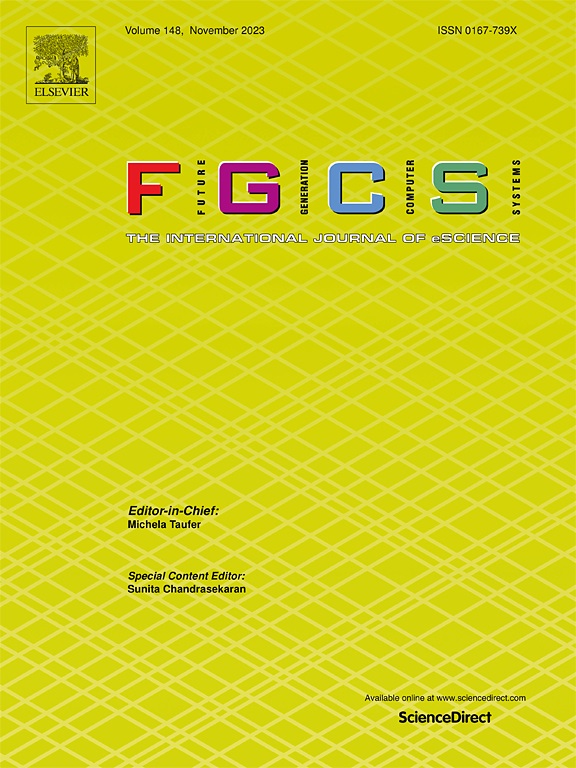Consolidation of virtual machines to reduce energy consumption of data centers by using ballooning, sharing and swapping mechanisms
IF 6.2
2区 计算机科学
Q1 COMPUTER SCIENCE, THEORY & METHODS
Future Generation Computer Systems-The International Journal of Escience
Pub Date : 2025-06-21
DOI:10.1016/j.future.2025.107968
引用次数: 0
Abstract
Data centers have major environmental impacts due to their energy consumption and the manufacturing of equipment. They emit greenhouse gases and consume energy and resources, such as rare earth and water. Efficient computing resource management is therefore a key challenge for Cloud service providers today as they need to meet a growing demand while limiting the oversizing of their infrastructures. Mechanisms derived from virtualization, such as Virtual Machines (VMs) consolidation, are used to optimize resource management and infrastructure sizing, but economic and technical constraints can hinder their adoption. They require prior infrastructure knowledge and usage study to evaluate their potential, involve complex placement algorithms, and are sometimes difficult to implement in hypervisors. In this paper, we propose ORCA (OuR Consolidation Algorithm), a complete consolidation methodology designed to facilitate the production implementation of such mechanisms. This methodology includes the study of VM usage, the use of prediction models, and a VM placement algorithm that takes advantage of resource oversubscription. The choice of relevant oversubscription ratios is also addressed, with a focus on memory overcommitment through the study of memory overcommitment mechanisms:ballooning, page sharing, and swapping. Results from a detailed simulation process and deployment on a production infrastructure are presented. The methodology is tested in simulation on two production infrastructure datasets, with power consumption reduction as high as 29.8% and without consolidation error. The production deployment using VMWare vSphere and considering fault tolerance requirements reduces the energy consumption by 6.12% without causing any performance degradation.
整合虚拟机,通过使用膨胀、共享和交换机制来减少数据中心的能源消耗
数据中心由于其能源消耗和设备制造而对环境产生重大影响。它们排放温室气体,消耗能源和资源,如稀土和水。因此,高效的计算资源管理是当今云服务提供商面临的一个关键挑战,因为他们需要满足不断增长的需求,同时限制其基础设施的超大规模。源自虚拟化的机制,如虚拟机(vm)整合,用于优化资源管理和基础设施规模,但是经济和技术限制会阻碍它们的采用。它们需要先前的基础设施知识和使用研究来评估其潜力,涉及复杂的放置算法,并且有时难以在管理程序中实现。在本文中,我们提出了ORCA (OuR Consolidation Algorithm),这是一种完整的整合方法,旨在促进此类机制的生产实现。该方法包括对VM使用情况的研究、预测模型的使用以及利用资源超额订阅的VM放置算法。还讨论了相关超额订阅比率的选择,重点是通过研究内存超额分配机制(膨胀、页面共享和交换)来关注内存超额分配。给出了详细的仿真过程和在生产基础设施上的部署结果。基于基础架构虚拟机使用分布的仿真结果表明,能耗降低38.8%。该方法还在两个生产基础设施数据集上进行了模拟测试,功耗降低高达29.8%,并且没有合并误差。使用VMWare vSphere并考虑容错要求的生产部署在不造成任何性能下降的情况下,降低了6.12%的能耗。
本文章由计算机程序翻译,如有差异,请以英文原文为准。
求助全文
约1分钟内获得全文
求助全文
来源期刊
CiteScore
19.90
自引率
2.70%
发文量
376
审稿时长
10.6 months
期刊介绍:
Computing infrastructures and systems are constantly evolving, resulting in increasingly complex and collaborative scientific applications. To cope with these advancements, there is a growing need for collaborative tools that can effectively map, control, and execute these applications.
Furthermore, with the explosion of Big Data, there is a requirement for innovative methods and infrastructures to collect, analyze, and derive meaningful insights from the vast amount of data generated. This necessitates the integration of computational and storage capabilities, databases, sensors, and human collaboration.
Future Generation Computer Systems aims to pioneer advancements in distributed systems, collaborative environments, high-performance computing, and Big Data analytics. It strives to stay at the forefront of developments in grids, clouds, and the Internet of Things (IoT) to effectively address the challenges posed by these wide-area, fully distributed sensing and computing systems.

 求助内容:
求助内容: 应助结果提醒方式:
应助结果提醒方式:


